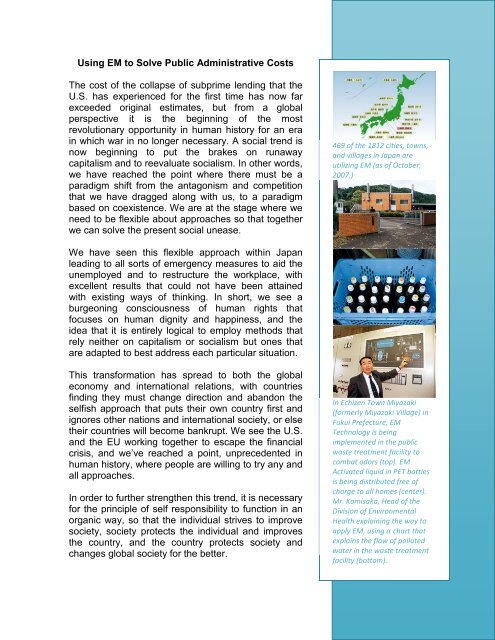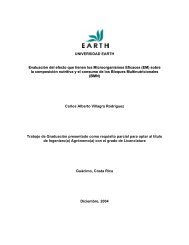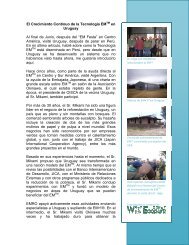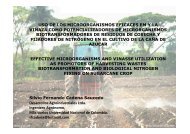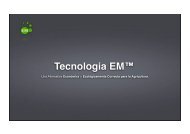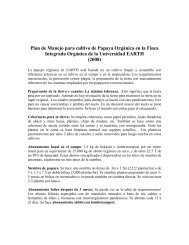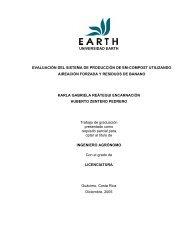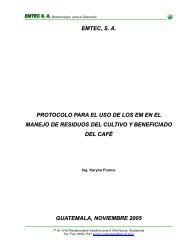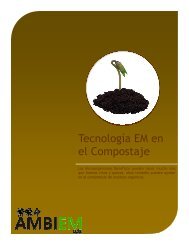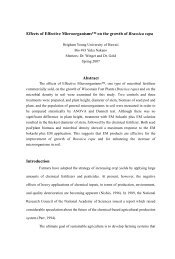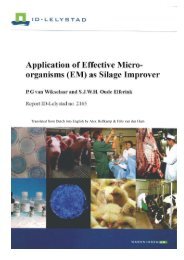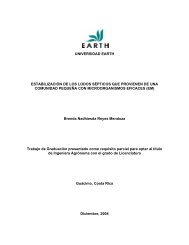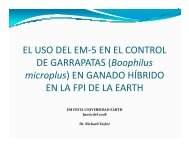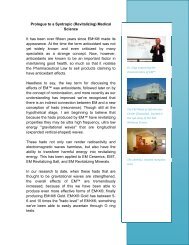download pdf. - EM | Effective Microorganisms
download pdf. - EM | Effective Microorganisms
download pdf. - EM | Effective Microorganisms
You also want an ePaper? Increase the reach of your titles
YUMPU automatically turns print PDFs into web optimized ePapers that Google loves.
Using <strong>EM</strong> to Solve Public Administrative CostsThe cost of the collapse of subprime lending that theU.S. has experienced for the first time has now farexceeded original estimates, but from a globalperspective it is the beginning of the mostrevolutionary opportunity in human history for an erain which war in no longer necessary. A social trend isnow beginning to put the brakes on runawaycapitalism and to reevaluate socialism. In other words,we have reached the point where there must be aparadigm shift from the antagonism and competitionthat we have dragged along with us, to a paradigmbased on coexistence. We are at the stage where weneed to be flexible about approaches so that togetherwe can solve the present social unease.469 of the 1812 cities, towns,and villages in Japan areutilizing <strong>EM</strong> (as of October,2007.)We have seen this flexible approach within Japanleading to all sorts of emergency measures to aid theunemployed and to restructure the workplace, withexcellent results that could not have been attainedwith existing ways of thinking. In short, we see aburgeoning consciousness of human rights thatfocuses on human dignity and happiness, and theidea that it is entirely logical to employ methods thatrely neither on capitalism or socialism but ones thatare adapted to best address each particular situation.This transformation has spread to both the globaleconomy and international relations, with countriesfinding they must change direction and abandon theselfish approach that puts their own country first andignores other nations and international society, or elsetheir countries will become bankrupt. We see the U.S.and the EU working together to escape the financialcrisis, and we’ve reached a point, unprecedented inhuman history, where people are willing to try any andall approaches.In order to further strengthen this trend, it is necessaryfor the principle of self responsibility to function in anorganic way, so that the individual strives to improvesociety, society protects the individual and improvesthe country, and the country protects society andchanges global society for the better.In Echizen Town Miyazaki(formerly Miyazaki Village) inFukui Prefecture, <strong>EM</strong>Technology is beingimplemented in the publicwaste treatment facility tocombat odors (top). <strong>EM</strong>Activated liquid in PET bottlesis being distributed free ofcharge to all homes (center).Mr. Kamisaka, Head of theDivision of EnvironmentalHealth explaining the way toapply <strong>EM</strong>, using a chart thatexplains the flow of pollutedwater in the waste treatmentfacility (bottom).
Since the beginning of the New Year I have had theseissues in mind as I’ve written this series. Up until nowI have mainly been dealing with the methods andphilosophy of applying <strong>EM</strong> in order for individuals tofulfill the principle of responsibility towards society.With the exception of Tokyo, where there is astructural concentration of finance, the majority ofother municipalities in Japan have begun torestructure as sustainable financial entities.I have long been explaining how if publicadministrative units and citizens systemicallyincorporate the use of <strong>EM</strong> into their daily lives, it ispossible for them to cut public administrative costs inhalf, and I have been assisting in all sorts of practicalapplications. In the beginning, local governments andthe national government didn’t want to have anythingto do with <strong>EM</strong>, but now they have recognized itseffectiveness. However, in order to fully demonstratethe power of <strong>EM</strong> and lower administrative costs byhalf, we must remember that it is of paramountimportance that <strong>EM</strong> not be used just as a substitutefor existing methods, but to transform administrativemethods.The No. 1 Case of Village Revitalization in Japanusing <strong>EM</strong>: Echizen Town Miyazaki (Formerly MiyazakiVillage) in Fukui PrefectureAfter merging with EchizenTown, the local administrationand residents are cooperatingin numerous projects.At the Nature FarmingTechnology Conference heldlast August (sponsored byINFRC, the International NatureFarming Research Center), Mr.Akira Mochizuki, assistantdirector of the AgricultureProtection Section of theProduction DevelopmentDivision of the Ministry ofAgriculture, was a panelist.The village formerly known as Miyazaki Village inFukui Prefecture, with a population of some 6,000,had a village debt of around 9 billion yen, and its percapita medical expenses were far and away thehighest in all of Fukui Prefecture. The village’sfinances were on the verge of collapse and they hadto obtain a special guarantee from banks to payvillage employees and tide them over during theirfinancial crisis.They were in exactly the same situation as largerrestructured financial entities, but at the time thenational and prefectural governments still hadfinancial reserves so they were somehow able tomanage. This was in 1995. Eight years later, MiyazakiVillage had the lowest medical costs in the prefecture,its village debt was almost zero, its population hadincreased, farming was revitalized, academicThis page courtesy of
achievement at elementary and middle schools, and school sports (mainlyvolleyball), were at the highest levels in Fukui Prefecture. People called MiyazakiVillage a miracle, and Village Chief Mr. Kimura, who had led the village from beingthe worst in Japan to the nation’s best, was invited to the annual garden partyhosted by the Emperor.These achievements continue today after the village has merged and is now calledEchizen Town. It will take a while for these achievements to be found throughoutthe town, however the achievements of the former Miyazaki Village have become agreat example for other local governments that are facing financial crises, so evenif this is somewhat old news, I'd like to reintroduce what happened in MiyazakiVillage.It all began with the aging water treatment facility (waste treatment facility) inMiyazaki Village. The center of the village was filled with a terrible odor, and moreand more villagers complained about losing their appetite. The village askedprofessionals to estimate the cost of repairs and this came to over one hundredmillion yen, which they couldn’t afford. At the time the village wasn’t even able toraise 50,000 yen, so instead they sought the advice of people who were using <strong>EM</strong>,came up with their own solutions, established a method of cultivating largequantities of <strong>EM</strong>, and they continued to use <strong>EM</strong> by the book until the odordisappeared.In about a week complaints about foul odors dropped off, and the villagers and thevillage office totally reevaluated <strong>EM</strong>. Originally many people in Miyazaki Villagehad been using <strong>EM</strong> with great success to recycle kitchen food waste, and for homegardens, and there were groups that were using <strong>EM</strong> in Nature Farming, and theywere all a great help to Mr. Kimura as he revitalized the village using <strong>EM</strong>. Afterresolving the issue of the waste water treatment, the village office formed an <strong>EM</strong>outreach project team, which successfully disseminated the use of <strong>EM</strong> in a widevariety of areas: organic waste recycling, using sewage to make organic fertilizer,utilizing <strong>EM</strong>-grown vegetables in school lunches, obtaining JAS organiccertification, applying <strong>EM</strong>-fermented rinsed rice water in homes, using <strong>EM</strong> inanimal husbandry, using <strong>EM</strong> to clean school swimming pools, restrooms, andclassrooms, and also in pottery and in secondary industries.Naturally, costs to treat organic waste and sewage went down markedly, they wereable to have reserves of several tens of millions of yen per year, and could providesubsidies, so they were now able to envision the projects that were truly necessaryfor the village. Before they knew it, the medical costs they had been covering weredrastically reduced, and the village now had the lowest per capita medical costs inall of Fukui Prefecture.Not only that, direct sales of <strong>EM</strong>-grown agricultural products, though only sold onthe weekends, reached ten million yen per month; most of these were grown inhome gardens and small-scale farms run by part-time farmers. Ten million yen permonth is an extremely great blessing in a farming village like this with an aging
population. The costs for these operations are so low because they use food wasteand other low-cost resources, so the ten million yen is almost all pure profit.Since the majority of households are utilizing <strong>EM</strong>-fermented rinsed rice water, it’snot necessary now to apply <strong>EM</strong> at the waste treatment facility because thepurifying function went up. Sludge is utilized as a high quality organic fertilizer, thedischarge water is a kind of magic water that is being widely used in farming and tocare for trees along streets, and furthermore it helps to purify rivers and streamsdownstream from the village.Wherever I went I stressed that all of Japan should follow the example of MiyazakiVillage, but at the time not only the national government but also the prefecture,and local governments were indifferent to <strong>EM</strong> and had no problem about opposing<strong>EM</strong>.In the present day, the situation has totally changed. The Organic FarmingPromotion Act has been established, and at organic farming conferences thatfocus on <strong>EM</strong>, section heads in the national government have become regularattendees. The government, both at the national and local levels, has changed itsmind completely about <strong>EM</strong>, and its former opposition is a thing of the past. “Got aproblem? Then turn to <strong>EM</strong>.” The national and local governments are in a difficultsituation right now, and have finally accepted <strong>EM</strong>. <strong>EM</strong>’s time has truly arrived.


